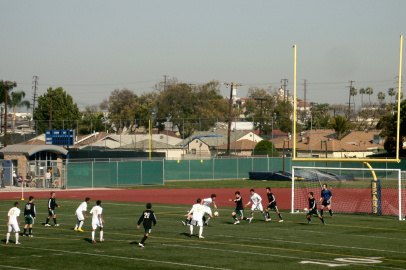| The LookOut columns | | What I Say |
| The LookOut columns | | What I Say |
|
|
 |
| The Santa Monica High School boys soccer team threatening to score in Saturday's game (Photos by Frank Gruber) |
To win its last games, the team overcame the loss of their star regular goalkeeper, Alex Kovacs, who was kicked in the face in Tuesday's game and couldn't play in the finals because his eye was still swollen.
Sophomore Michael Friedman took his place, the invincible defense stepped up another notch, young Friedman did all he was asked to do, and they won.
| Members of the champion Santa Monica High School boys soccer team with their trophy: L-R Tyler Horton, Gerardo Romero, Luis Zavala, Orhan Basak, & Charlie Paris; holding the plaque, Artur Jozkowics. |
For more photos and to get a sense of the excitement the team has generated, log on to the Samohi soccer website [http://www.samohisoccer.com/].
* * *
All this excitement reminds me of one sobering thought -- Henry is graduating in June and my wife and I will soon be empty-nesters. But I won't bore you with our impending angst. Instead I'll try to tie our angst into bigger issues affecting Santa Monica.
Last month the New York Times ran a travel article on Santa Monica. Maybe you saw it, but if not, here's the link. While I have been wary about accuracy in the paper of record ever since it printed stories by Judith Miller that paved the way for the invasion of Iraq, I was a little surprised to see that the article says that Santa Monica's population is 96,000.
I don't know where the Times got this figure, but it's wildly exaggerated. The population at the last census in 2000 was 84,000 (down from 1990 and largely unchanged since 1960). Although some hundreds of housing units have been built in Santa Monica since then, it's inconceivable that the population has increased by 12,000.
The City has a habit of overestimating population growth -- in the '90s signs at the entrance to Santa Monica said our population was 92,000. As I have written before, my theory is that the demographers consistently forget to count the number of high school seniors who graduate, leave home, and never come back.
Take our Henry. When he leaves for college next year, the population of our house will decline 50 percent. He may for a few years while he's in college officially live in our house, and he may be counted there in the 2010 census, but he's likely gone from Santa Monica for a long time. Meanwhile, my wife and I love our house and, with hope that we can age in place, we expect to live in it also for a long time.
Meanwhile, Santa Monica has become so expensive, and so few housing units for families are available, that few young families with children can move here.
They know all about this phenomenon over at the school district, where declining enrollments are causing a financial crisis.
I'm not saying that families with children have any more right to live in Santa Monica than households without children, but I believe strongly from an urbanism standpoint that there is a positive good in having a community that accommodates households with people of all ages, just as there is a positive good in having a community with all income levels and a mixture of ethnicities.
The trend in development in Santa Monica for nearly thirty years has not supported this diversity. During that time, little housing was built compared to the amount of business-oriented development, and little of the housing that was built consisted of family-friendly units with at least three bedrooms.
Although much of the rhetoric about development issues for the past decades has been about preserving the character of Santa Monica, the ironic result has been that the houses here have become too expensive for young families, the kind with school-aged children, and Santa Monica has changed more because of that than because of any buildings that have been built.
Last Wednesday night the Planning Commission reviewed a report from the planning department about proposed land use designations for the update to the land use element of the City's general plan, and previous to that, on Feb. 26, the City Council gave its support to the direction the update is going. (To obtain the planning commission staff report, which I recommend reading, go to the agenda and click on the staff report for Item 9-A.)
There is not space in this column to go over the details of these proposals, but I do want to say that essentially what the staff is talking about is to keep the development standards in most of the city, including in existing residential neighborhoods, the way they are, but to allow for development of new neighborhoods, with workforce and affordable housing, in areas of the city that are currently industrial or commercial.
There will be debate about issues such as the amount, size, and form of development in these new neighborhoods, but this direction is the correct one to take, because Santa Monica would not be Santa Monica -- it would not have the same "character" to use that overused word -- without children.
| If readers want to write the editor about this column, send your emails to The Lookout at mail@surfsantamonica.com . If readers want to write Frank Gruber, email frank@frankjgruber.net The views expressed in this column are those of Frank Gruber and do not necessarily reflect the opinions of The Lookout. |
Copyright 1999-2008 surfsantamonica.com. All Rights Reserved. |